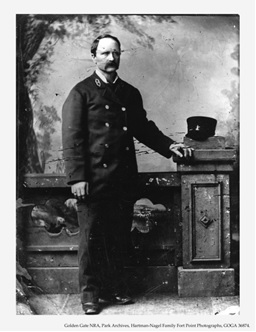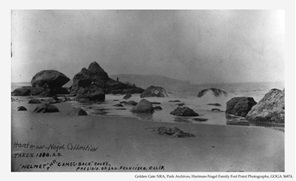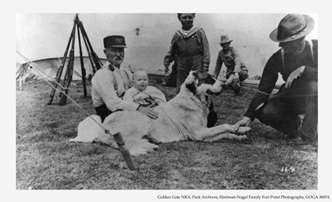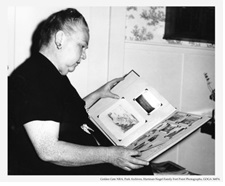James Rankin was born in Killashee County, Ireland on 20 February 1844 and immigrated to the United States in 1867. He attended Kings College in Pennsylvania, and then joined the U.S. Coast Survey with which he served as a Boatswain on a steamer. He then joined the Lighthouse Service in 1877, and for the first year of his career served as the keeper of  East Brother Island Light Station in Richmond, California. Transferred to the Fort Point Light Station in 1878, he stayed at this station in San Francisco until 1919—an unusually long stay for a keeper at one lighthouse.
East Brother Island Light Station in Richmond, California. Transferred to the Fort Point Light Station in 1878, he stayed at this station in San Francisco until 1919—an unusually long stay for a keeper at one lighthouse.
 The lighthouse at Fort Point to which Rankin was appointed had been constructed in 1863. At 106 feet above sea level, the light could be seen by sailors along the entire horizon. Rankin and an assistant operated the fort's lighthouse, and, when not performing their main duty of attending the light's oil lamps, they scrubbed, dusted and painted. The lamps burned hard oil or kerosene, which the two men hauled up narrow stairs until 1910, when incandescent lamps were installed. They also constantly trimmed the lamp's wicks to keep the light bright and the lens clear of smoke. In addition, the keepers wound and maintained the clockwork mechanisms that ran the light and fog bells. The light had to burn at all times, regardless of weather.
The lighthouse at Fort Point to which Rankin was appointed had been constructed in 1863. At 106 feet above sea level, the light could be seen by sailors along the entire horizon. Rankin and an assistant operated the fort's lighthouse, and, when not performing their main duty of attending the light's oil lamps, they scrubbed, dusted and painted. The lamps burned hard oil or kerosene, which the two men hauled up narrow stairs until 1910, when incandescent lamps were installed. They also constantly trimmed the lamp's wicks to keep the light bright and the lens clear of smoke. In addition, the keepers wound and maintained the clockwork mechanisms that ran the light and fog bells. The light had to burn at all times, regardless of weather.
 The keeper's job was not easy, and the loneliness and hard work were too much for many. The Fort Point lighthouse had seven keepers and fourteen assistants in its first ten years, eleven of whom resigned within a year. To keep the loneliness at bay, Rankin married while at Fort Point, where he also had two children with his wife, Nellie: Edna Neval, born on 7 March 1880, and Arthur, born in 1894. Although dedicated to his profession, he admitted to the job's dullness when he told a reporter in 1915 there was nothing to see at Fort Point. "There is ocean and the sand and the guns and the soldiers. That is all. It grows monotonous. Always the ocean and the sand and the guns and the soldiers. As for the ships, one grows tired of them, too." To counteract the boredom, he had his family and his "pleasures," which included painting landscapes of the monotonous scenery spread before him. There were, however, occasional excitements. While on duty, he rescued a couple who had slipped and fell into the Bay after drunkenly dancing along the seawall at Fort Point. A fisherman who had witnessed the couple fall into the water notified Rankin of their distress, at which news he immediately stripped off his clothes and dove into the water. The woman, who had been kept afloat by air pockets generated by her full skirt, was rescued by Rankin and purportedly screamed in alarm at being pulled from the water by a partially naked man—the only one the Victorian lady had ever seen besides her own husband; for his efforts, Rankin received a special commendation.
The keeper's job was not easy, and the loneliness and hard work were too much for many. The Fort Point lighthouse had seven keepers and fourteen assistants in its first ten years, eleven of whom resigned within a year. To keep the loneliness at bay, Rankin married while at Fort Point, where he also had two children with his wife, Nellie: Edna Neval, born on 7 March 1880, and Arthur, born in 1894. Although dedicated to his profession, he admitted to the job's dullness when he told a reporter in 1915 there was nothing to see at Fort Point. "There is ocean and the sand and the guns and the soldiers. That is all. It grows monotonous. Always the ocean and the sand and the guns and the soldiers. As for the ships, one grows tired of them, too." To counteract the boredom, he had his family and his "pleasures," which included painting landscapes of the monotonous scenery spread before him. There were, however, occasional excitements. While on duty, he rescued a couple who had slipped and fell into the Bay after drunkenly dancing along the seawall at Fort Point. A fisherman who had witnessed the couple fall into the water notified Rankin of their distress, at which news he immediately stripped off his clothes and dove into the water. The woman, who had been kept afloat by air pockets generated by her full skirt, was rescued by Rankin and purportedly screamed in alarm at being pulled from the water by a partially naked man—the only one the Victorian lady had ever seen besides her own husband; for his efforts, Rankin received a special commendation.
Another break to the monotony were visits from his daughter and her family. Edna had married the son of a 3rd U.S. Infantry officer, Franz August Nagel, with ties to the Presidio. She and her husband, August, had five of their own children: Meriam Beatrice, Alberta Virginia, Velma Louise, Arthur, and August Arthur Nagel—all born in San Francisco. During their trips to Fort Point, often with the family of Mrs. E.C. Hartman—sister to August, the Nagels brought their camera with which they took photographs of the children with their grandfather, cavorting along the beach beside grand old Fort Point. These photographs showcase Fort Point and its companion Lighthouse and Fog Signal, the Keepers' dwellings long since demolished in the wake of the Golden Gate Bridge, and also the surrounding landscape through the intimate lens of a family which was connected to the Fort for over 40 years. When James Rankin retired in 1919, he was commended for saving a total of 18 lives from the sea—a feat so impressive the U.S. Coast Guard cutter James Rankin was  eventually named in his honor. Shortly after his retirement, he died in Antioch on 5 January 1921 and was interred in the San Francisco National Cemetery at the Presidio of San Francisco. His wife, Nellie, was laid beside him upon her death on 15 January 1932, and nearby are the graves of his relatives, the Nagels—Franz, his wife, Genevieve, and three of their children: Sophie Louise, William Maben, and Dorothy "Dora" Edna Nagel.
eventually named in his honor. Shortly after his retirement, he died in Antioch on 5 January 1921 and was interred in the San Francisco National Cemetery at the Presidio of San Francisco. His wife, Nellie, was laid beside him upon her death on 15 January 1932, and nearby are the graves of his relatives, the Nagels—Franz, his wife, Genevieve, and three of their children: Sophie Louise, William Maben, and Dorothy "Dora" Edna Nagel.
In 1973, the Presidio Army Museum (PAM) acquired the images featured here from James Rankin's granddaughter, Meriam, who had become a devoted volunteer of the Fort Point & Army Museum Association in her later years, along with her two nieces—Melinda and Candice Nagel. Included in the collection are landscape views from the 1880s; James Rankin fraternizing with his expanding family on Fort Point grounds from 1900 to 1915; a series which documents the construction of the lower level Keepers' residence; a section which documents the interior and exterior of the Fort Point fog signal bell, its house and lighthouse engine; and images which show the Fort, the Keepers' dwellings, the rain shed and the fog signal and lighthouse bridge from various angles. The collection finishes with a series of photographs documenting the Nagel-Fort Point Museum Association partnership, depicting Meriam with items she donated and her two young nieces—Candice and Melinda—volunteering at the Fort in 1969.

